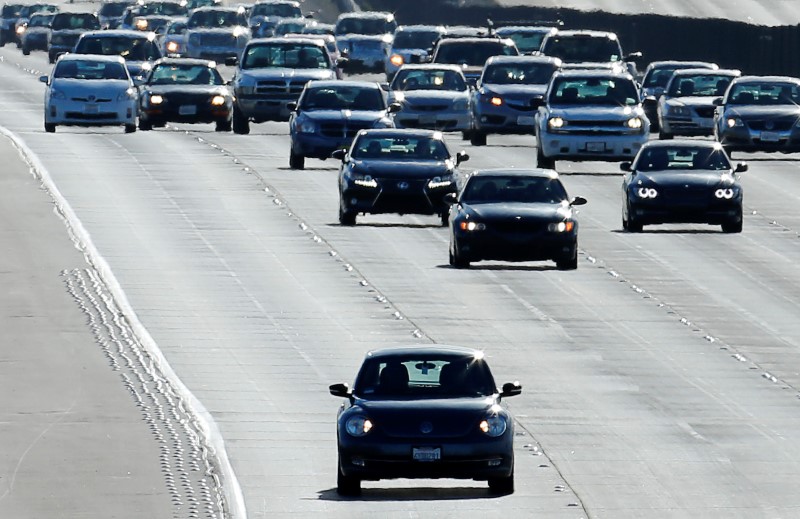By David Shepardson
WASHINGTON (Reuters) - Auto safety regulators on Tuesday called for a major overhaul to U.S. crash safety tests that will require automakers to add crash avoidance technologies to new vehicles if they want to gain the top, five-star ratings.
The U.S. National Highway Traffic Safety Administration is proposing three new ratings for cars and trucks on pedestrian safety, crash worthiness and crash avoidance under its New Car Assessment Program, according to the 195-page proposal made public Tuesday.
"We're going to raise the bar," U.S. Transportation Secretary Anthony Foxx said, adding that the new "tougher" standards are more accurate and will prod automakers to do more, including to make safety technology standard on all new vehicles.
NHTSA's proposal would push automakers to add advanced technologies including forward collision warning, lane departure warning, blind-spot detection, lower beam head lighting, semi-automatic headlamp beam switching, amber rear turn signals, rear automatic braking and pedestrian automatic emergency braking.
For the first time, NHTSA will base the crash test ratings for vehicles on whether the manufacturer has included certain crash avoidance technology. Automakers covet five-star ratings, so the new measures could effectively require manufacturers to make technology currently offered as pricey options on some vehicles standard equipment on all vehicles. That could save lives, but add to the costs of new vehicles.
The new ratings are scheduled to take effect in the 2019 model year. NHTSA would add a new frontal crash test, new pedestrian crashworthiness testing and add two new advanced crash test dummies in testing that would detect additional injuries. NHTSA will also add "half star" ratings for more differentiation between vehicles, Foxx said.
Pedestrian safety is a big issue. Pedestrian deaths now account for about 14 percent of all road deaths, or 4,800 deaths a year, compared with 8 percent in 1975, or about 4,000.
The scores from the three new ratings would be a factor in determining vehicles' overall one-to-five-star crash ratings. Automakers would receive partial credit for advanced technologies that are not standard on all versions of individual vehicles.
NHTSA officials want to help consumers differentiate between vehicles. The tests are only to set crash ratings that are included on new car window stickers - not for crash tests needed in order for vehicles to be legally sold in the United States.
The U.S. Congress recently passed a highway bill that requires NHTSA within one year to require that crash avoidance information is included on new vehicle window stickers.
Last month, NHTSA said it was adding two automatic emergency braking systems to recommended safety features, but it has repeatedly declined to propose mandating the technology.
In September, 10 major vehicle manufacturers said they have agreed in principle to make automatic emergency braking a standard feature on all future vehicles, but they have not set a time frame.
In 2012, rear-end crashes killed 1,705 people and injured 547,000 in the United States. The systems could prevent many of those crashes, NHTSA says.
NHTSA is releasing a request for comment and will give automakers and the public 60 days to respond. It expects to finalize the changes to the five-star program next year, but the changes to the vehicle sticker will require formal rulemaking, which could take longer to finalize.
This is the latest effort to toughen the tests.
In 2007, the George W. Bush administration unveiled tougher car safety crash tests and added a side impact test to the five-star crash ratings.
At the time, the administration proposed giving automakers a letter grade for how quickly they added advanced technology systems to vehicles, but that plan was later dropped.
NHTSA unveiled the program in 1978 as a way to encourage automakers to voluntarily invest in safety technologies. In the beginning, vehicles received pass/fail marks rather than stars, which started in 1994.
The Alliance of Automobile Manufacturers - the trade group representing General Motors Co (N:GM), Ford Motor (N:F) Co, Toyota Motor Corp, Volkswagen AG (DE:VOWG_p) and others - said on Tuesday it was "pleased that NHTSA sees new safety technologies pioneered by automakers are performing well in the real world and should be featured in their consumer education program."
The group added: "Crash-avoidance technologies can be life-saving innovations that we're eager to see consumers embrace. Looking ahead, a significant portion of future highway safety gains will likely come from these advanced technologies."

Another auto trade group, the Association of Global Automakers - representing Honda Motor Co, Nissan Motor Co and others - said the government should take a "measured approach." The group called for a "thoughtful, data-driven process that leads to real world safety improvements, and provides consumers with clear and accurate information to enable more educated buying decisions."